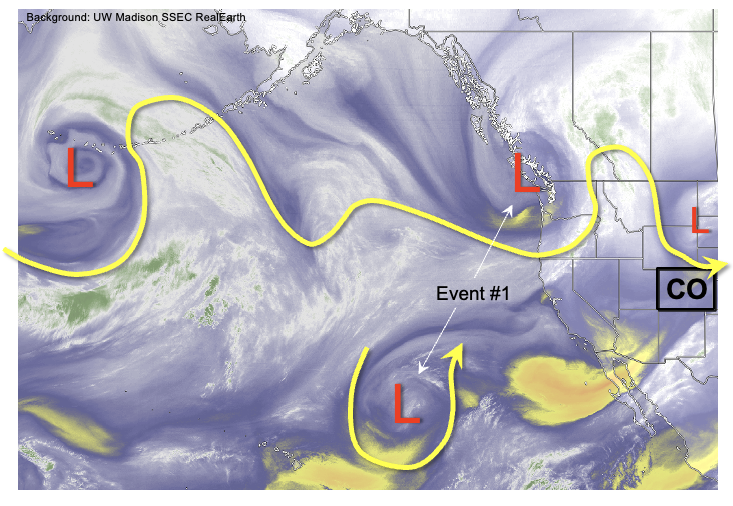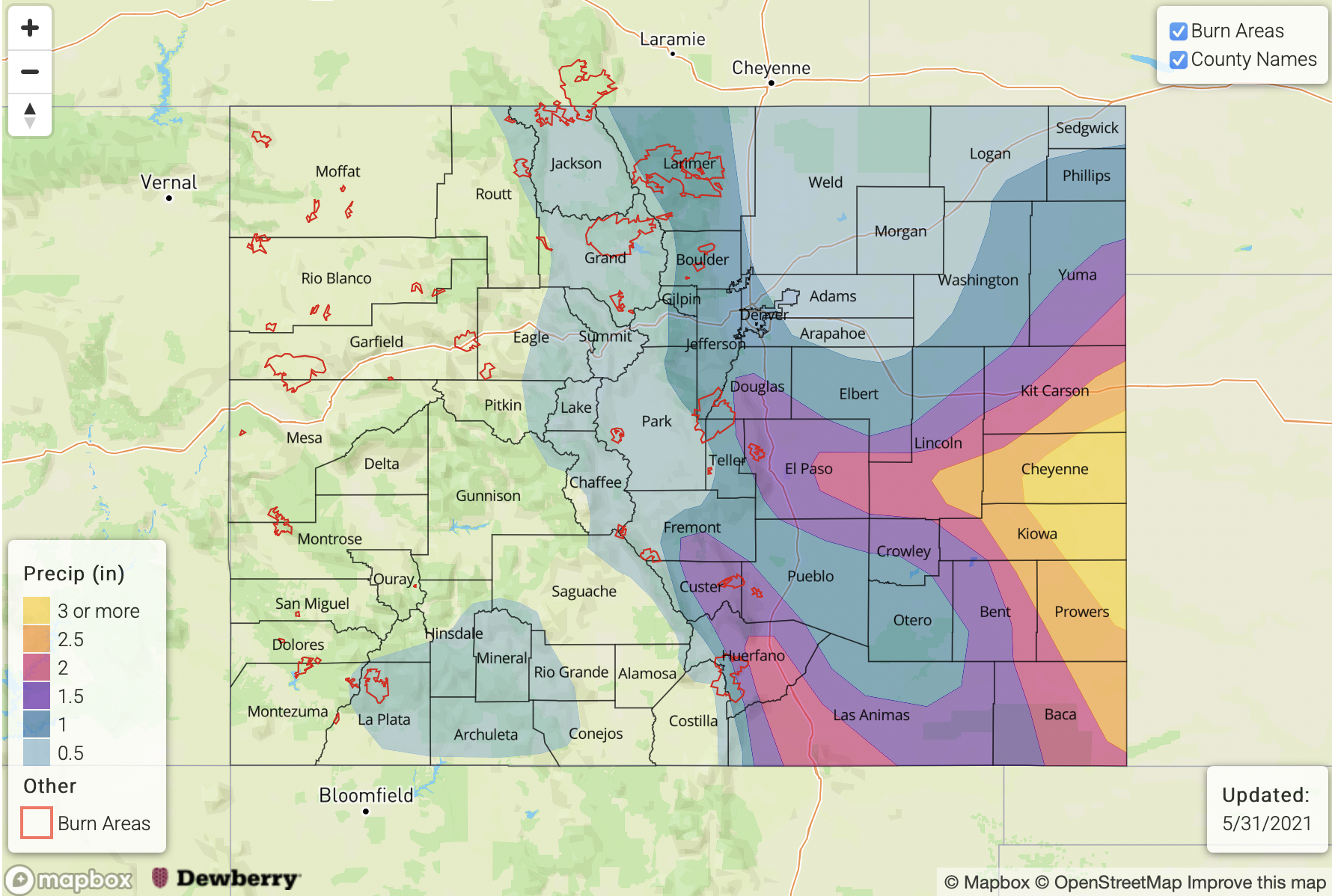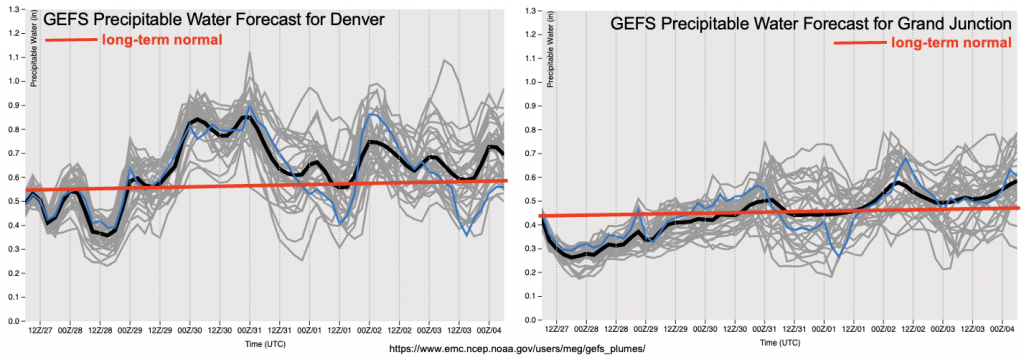Issue Date: Thursday, May 27, 2021
Issue Time: 1:30PM MDT
Valid Dates: 5/28-6/11
As shown in today’s water vapor image, below, a very active pattern remains in the eastern Pacific Ocean and western North America. The southward extent of the disturbances, and most notably the continued occurrence of cut-off circulations, is what makes this pattern a bit unusual for this time of year. Typically, late May is a time when the southwest United States upper-level ridge gradually begins to build in the lead-up to the monsoon season.
Beginning close to home, we see Colorado will be under a transient (i.e. passing) mid-level ridge, leading to excellent weather for most of the state. However, the next precipitation event, Event #1, will quickly be developing from two separate areas. An upper-level trough currently off the Washington state coast will move southeastward towards Colorado. This will cause synoptic-scale upward motion in the upper-levels, while steering a cold front across the state over the weekend. Meanwhile, the cutoff disturbance northeast of Hawaii will also gradually be picked up by the jet stream flow, prolonging the duration of unsettled weather mainly east of the Continental Divide.
As shown in the GEFS forecast PW plumes, we see a very distinct surge of moisture in the Denver forecast, with PW approaching 1 inch. However, one important caveat regarding heavy rainfall chances is that the strong cool front will likely limit instability along and north of it. In fact, the trend in model guidance over the past 24-48 hours has significantly cooled boundary layer temperatures north of I-70, which will cause more gentle, stratiform precipitation here. The real area of interest for this event, from the perspective of heavy rainfall and flooding will be over the southeast quadrant of Colorado, where Saturday and Sunday will have a well-juxtaposed combination of moisture, instability and relatively light steering winds to warrant an Elevated flood threat. Unlike the past two precipitation events, heavy rainfall will likely be the dominant threat with Event #1, as opposed to severe weather, given relatively weak wind shear.
Before moving on, and of relevance to Event #1, it is worthwhile to discuss just how impressive some of the spring precipitation has been across parts of eastern Colorado. The map below shows 30-day total precipitation as estimated by the NOAA Stage IV product, which takes into account both rainfall gauges and radar estimates. Widespread parts of eastern Colorado have received over 5 inches of rainfall, with isolated locations exceeding 8 inches and approaching 10 inches over this period. For reference, 10 inches of rainfall over eastern Colorado over a 30-day period equates to roughly a 1% chance of occurring (i.e. also sometimes referred to as a 1 in 100 year event). If the precipitation totals forecasted for Event #1 materialize, some of these locations could approach or even exceed 0.2% (1 in 500 year) or even possibly 0.1% (1 in 1000 year) chances of occurrence. Given that all of this rainfall has occurred, thus far, without significant flooding is certainly welcome news.
The last matter to discuss in this Outlook is snowmelt. As discussed in past Outlooks, most major river basins are expected to see below normal snowmelt and flow (or even significantly below normal, like the Colorado River). The one exception continues to be the South Platte River, and more specifically its tributary, the Cache La Poudre. As shown in the hydrograph below, the river has experienced above normal flow, sometimes significantly so, for nearly one month now. With the upcoming Event #1, this flow will continue to rise. Furthermore, much warmer temperatures by later next week imply the first prolonged pulse of high elevation snow-melt in this basin. In short, we expect significantly above normal peak flow to occur sometime in June. An Elevated flood threat has been issued starting late next week in anticipation of the high elevation snow melt. However, it is not yet clear whether the river will actually enter flood stage at this time, so stay tuned.
Below, we discuss the identified precipitation event in more detail.
Event #1: Friday-Wednesday (May 28 – June 2)
A prolonged, Elevated Flood Threat through the period for repeated rounds of heavy rainfall
Thunderstorm activity will increase in coverage beginning Friday, but especially on Saturday through Memorial Day (Monday) as the trough and cold front combination approach Colorado. On Saturday, we expected areas east of the Continental Divide to see at least short-term heavy rainfall, but flooding concerns should stay limited to the Northeast Plains and Southeast Plains where 1-hour rainfall up to 2.0 inches and 3-hour rainfall up to 3.5 inches will be possible. By Sunday, a cool front will limit instability in northern Colorado, but already saturated areas in eastern Colorado will see another round of heavy rainfall with maximum 1-hour intensity up to 1.9 inches and 3-hour intensity up to 3.7 inches. Overall, isolated locations mainly along the Kansas border south of I-70 will likely experience over 5 inches of rainfall over a 48-hour period. Isolated flash flooding will be possible along with some flooding of smaller tributaries in the Arkansas and Republican river basins. By Monday, the threat will shift southward towards the NM border, as cool stable air should prevail further north. Max 1-hour rainfall up to 1.5 inches per hour over the Raton Ridge warrant a continuation of the Elevated threat.
It is also important to note that eastern Colorado “major” fire burns (East Troublesome, Cameron Peak, Calwood and Spring Creek; see Fire Burn Forecast page) will be under elevated threat during the coming period. At this moment, it appears Spring Creek will see the highest potential for runoff issues, as the burn areas further north should experience a limited duration of high rainfall intensity.




